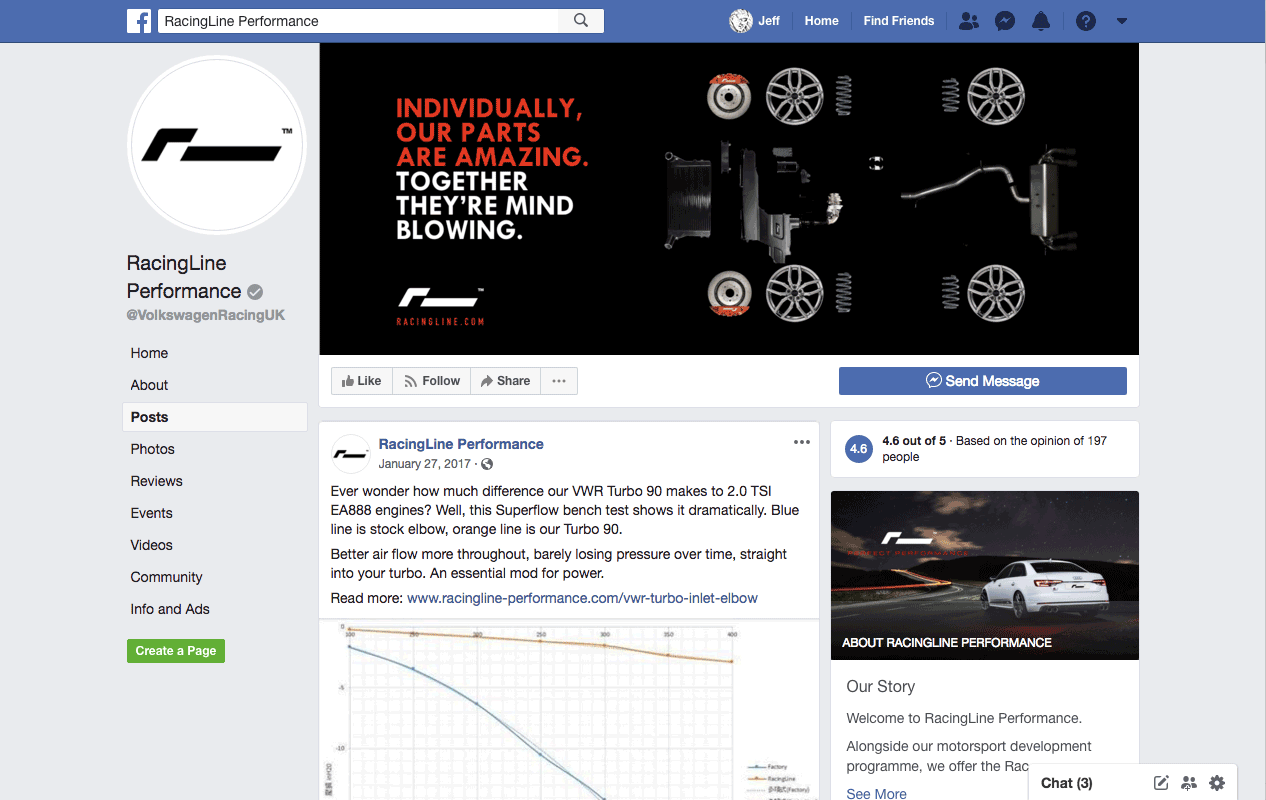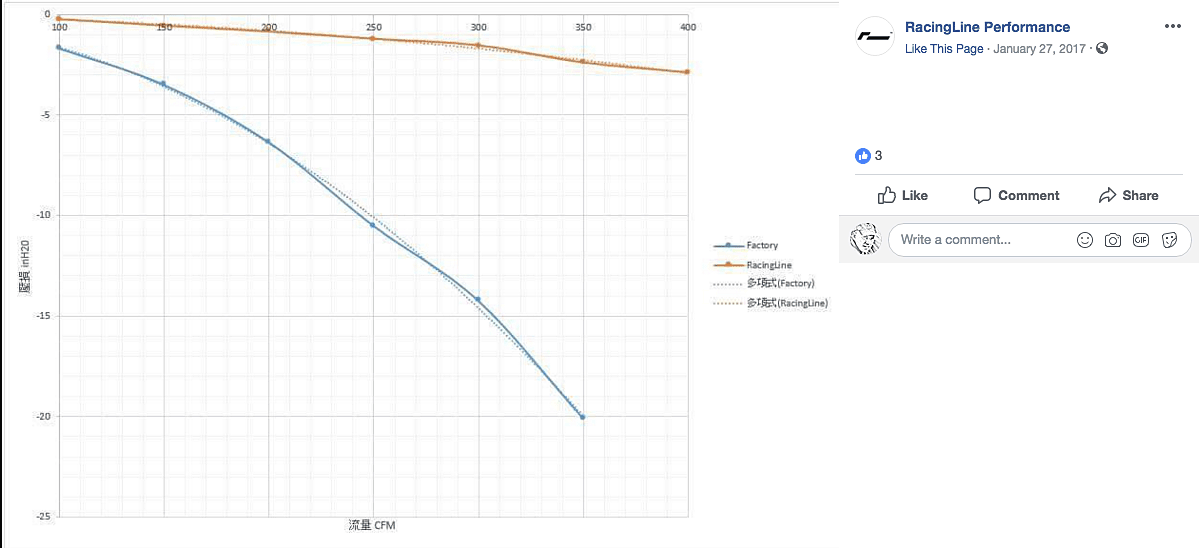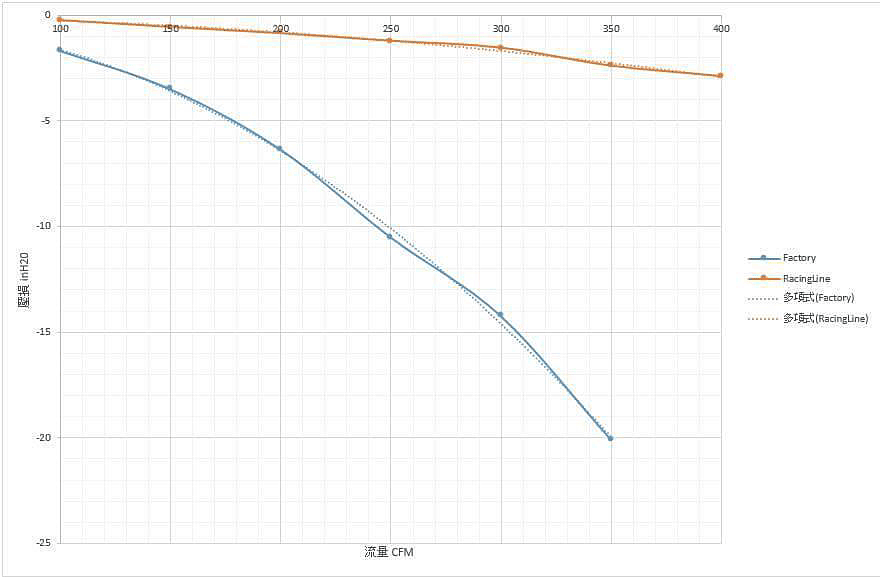BLUF: Something likely went wrong during the RacingLine airflow testing because the results are abnormal.
Recent turbocharger inlet elbow flow testing was successful in evaluating a large number of vendor products for the Mk7 GTI and Golf R.
One of the vendors that did not respond to the request was RacingLine who produce the VWR High-Flow Turbo 90 inlet elbow. Some searching of the RacingLine website and Facebook page turned up a post on the Facebook page describing an airflow test that was performed with a stock inlet elbow and also the VWR Turbo 90 elbow.

Of particular interest is the comparison chart of airflow differences between the two products.

As the post states, the graph shows the differences in dramatic fashion. The VWR inlet elbow has a fraction of the pressure drop that the stock inlet elbow does.

In order to compare these results to the results obtained in the TIP ranking tests the depression should be adjusted to 28″ of H2O. This is a reasonable extrapolation in the case of the stock elbow that was measured out to 20″ of H2O. At 28″ it would have flowed approximately 414 CFM. As shown on the chart below, this is slightly higher than what was recorded during the TIP ranking tests and higher than what APR reports measuring with the stock inlet elbow.

VWR results are approximately 12% greater than the results from the TIP ranking tests.
Note: The stock elbow airflow in the chart above from the TIP ranking is a few CFM higher than measured when using the 3D printed adapter, this reading was made with a larger outlet adapter. This was done because it is unknown what size adapter RacingLine used in their flow testing and thus results from a larger adapter were used with the assumption that some of the increased airflow RacingLine recorded was a product of the outlet adapter diameter. The takeaway is that the RacingLine results were not abnormally out of line with those from the TIP ranking tests and APR reported measurements.
When the RacingLine VWR Turbo 90 inlet airflow is adjusted to the 28″ of H2O depression the resulting value is approximately 1200 CFM.
Once again assuming that the outlet adapter that RacingLine used was larger than the IS20/IS38 compressor housing inlet, TIP testing results from using a larger silicone hose adapter are used for comparison. This comparison is shown in the chart below:

What immediately jumps out is how much more airflow RacingLine is reporting from the VWR Turbo 90 inlet versus several of the inlets measured during the TIP ranking. The gain over stock is reported to be 190% greater. In comparison the best performing inlet pipe from the TIP ranking produced gains of about 34% over stock.
With the huge disparity in results it is at this point that the question arises “was something done incorrectly“?
Doing a sanity check of the results there is a reasonable amount of agreement between the stock inlet elbow results measured during the TIP ranking and those reported by APR. There is also reasonable agreement between the aftermarket elbows measured in the TIP ranking and what is reported by APR for their elbow (12% difference) and also by Unitronic for their elbow (7% difference). The results for the TIP ranking products are high confidence.
The chart for RacingLine reports that at 400 CFM of airflow the pressure loss through that inlet elbow is just under 3″ of H2O. By comparison, every other inlet elbow tested during the TIP ranking, and by APR and Unitronic, are generating 28” of pressure drop at a comparable airflow. This is a very large inconsistency between RacingLine results and all of the other available data.
Conclusion:
Something most likely went wrong during the RacingLine VWR Turbo 90 airflow tests. The results are inconsistent with all other data available for this comparison.

Is it just me but doesn’t the VWR TIP looks almost exactly like the BMS TIP?
There are some others that also look a bit alike as well.